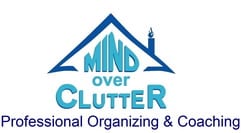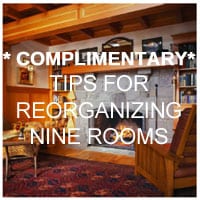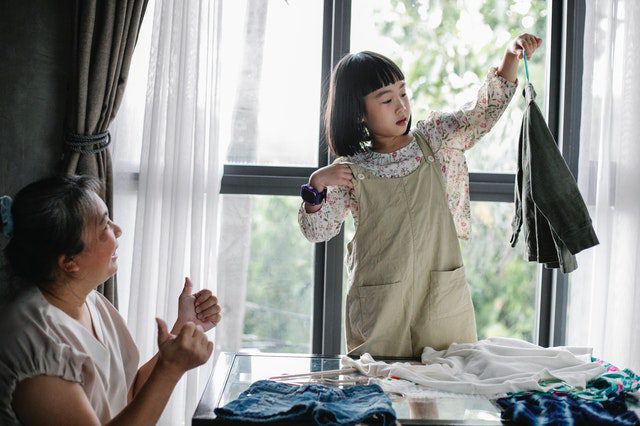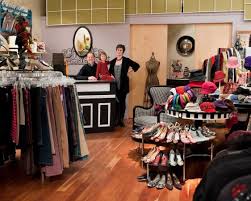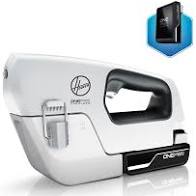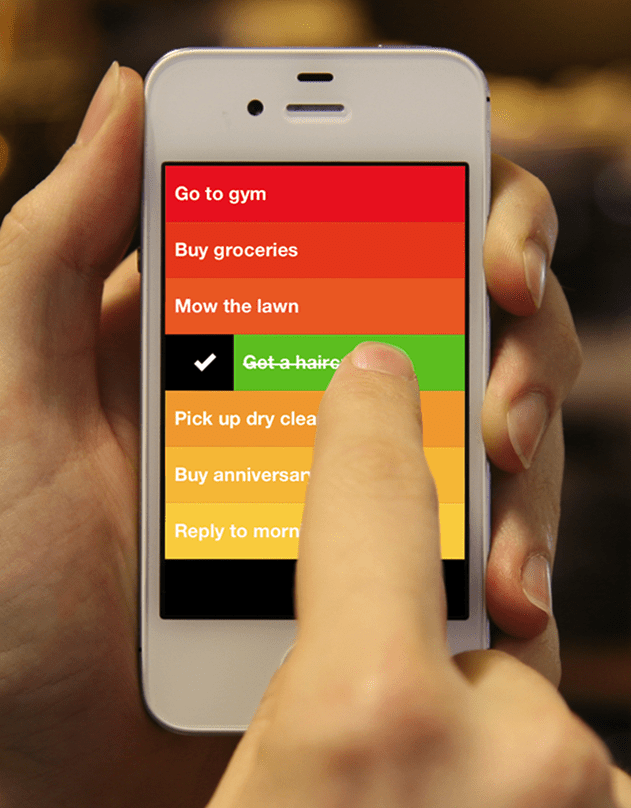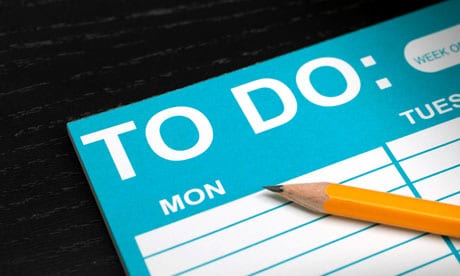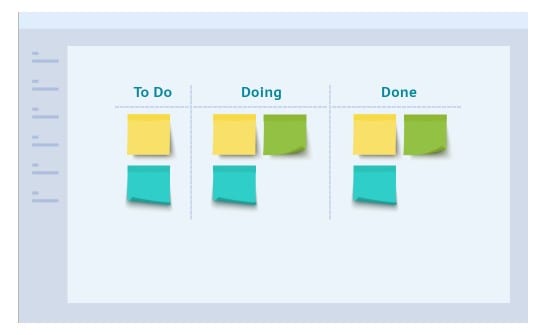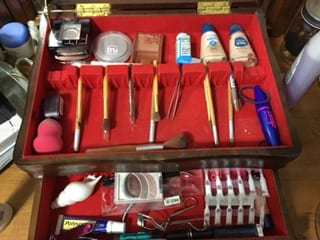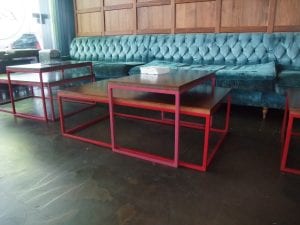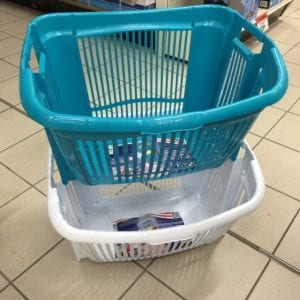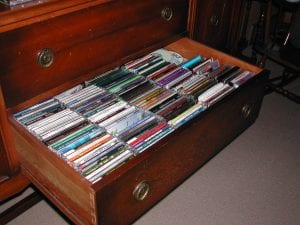Latest Blog Posts

My guest blogger this month is Marija Trifunovic from Arizona Moving Professionals.
A neat and organized kitchen space and pantry reflect how well you manage your meals and your household in general. People with large families know that keeping everything neat is often challenging when you also need to stock up on food. Luckily, there’s a way to reorganize your pantry and make sure it looks good and is practical and easy to manage. Let’s go through some super helpful pantry organization ideas that will help you make it neat as a pin – and keep it that way!
Create a unified look with plastic stackable containers
With all the foods in containers of different shapes and sizes, it’s easy to lose track of what you’ve got in your pantry. That’s why packing all of the foods in a one-style container will make it super organized and easy to use. Find see-through, stackable containers that you can use for different types of food such as rice, grains, flour, pasta, cereals, and more. If they’re made of see-through plastic, it will be easier to see what’s inside and how much food is left.
Labels
You can make labels for all the contents in your pantry for easier organization. You can even buy blank stickers and write what’s inside each jar or container. Labels make it easier to manage the pantry, and the space will look even better if you use the same style everywhere.
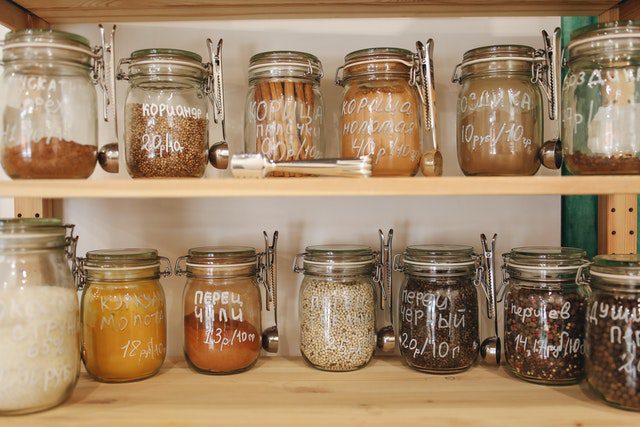
Pull-out cabinets for reaching items in the back
Oil bottles, spices, and similar items often get stuck in a cabinet, so you use only the bottles or jars in front, forgetting about the ones in the back. Well, how about a cabinet you can pull out like a drawer and see all the items in it? You can custom-make it to fit your pantry or turn one regular cabinet into a pull-out one.
Use dividers
Use dividers to help you organize your drawers and cabinets whenever you can. Drawer dividers and organizers are probably the best way to keep the mess out, as you need to put the items back as they were. They’ll keep your drawers and cabinets as tidy as possible.
Create a spice rack
One of the best ways to organize and use up all the spices is to have them on display and see what you’ve got. Firstly, pour them into all the same jars and label each jar clearly. Next, use a simple book or picture shelf for all the jars. You can hang it on the back of the pantry door or a wall. This is one of the pantry organization ideas that will help with smart storage management, too. It’s perfect for small kitchens and pantries where you want to use every inch of space.

Go vertical
You might feel like you’ve got enough space in your pantry, but creating more space options will make every space look better. Use up the vertical space in your pantry by adding some shelves on top of the cabinets. Also, you can place a couple of baskets on the highest shelves and use them for things you don’t use daily. These are often seasonal items, holiday food tools, supplies, etc. Finally, use baskets to fill any open shelves that look messy. You can hide things in baskets to make the shelves look good and have everything tidy and in its place.
Bonus tip: using the vertical space in your pantry might result in shelves too high to reach. There’s a simple solution for this – a library ladder. Use to reach items that are placed high and have a spacious and organized pantry simultaneously.
Easy access to items you use daily
When organizing a pantry, the most crucial factor is how often you use something to cook. The priority factor will help you manage your foods to make the ones you need daily easily accessible. Sugar, flour, pasta – ensure these are placed in secure containers suitable for everyday use and put in a place where you can easily reach them.
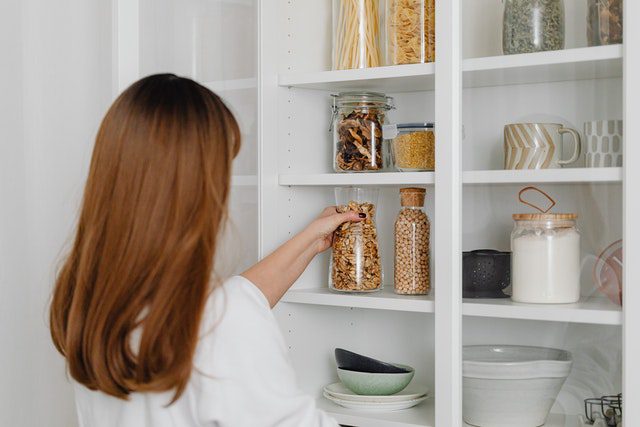
Create a coffee and tea station
If you’re into morning or evening rituals of drinking tea and coffee, you simply need a station for making your favourite drink. Get a box or organizers for all the tea bags, coffee capsules, and other items you need to make your perfect morning cup of joy. Also, keep it together with your favourite cups and everything else you need to use or maintain your coffee machine. It will make this task much faster and easier once you have everything in one place.
Get a pegboard
This is one of the ideas for pantry organization you can use in other rooms in the house, such as your office, garage, or crafts room. Pegboards are a fantastic tool for organizing smaller items you need to prepare food – hang knives, measuring spoons, cutting boards, etc. You’ll use vertical space and clear-out cabinets and drawers.
First things first…
It’s important to know exactly how much space you have, so do a serious decluttering session first. Take everything out and remove all items that passed expiration dates, got spoiled, etc. Also, taking everything out for a moment will help you see how much space you have in your pantry. It will also make it easier to visualize the area and see which of the pantry organization ideas will work the best. Decluttering also works wonders for the entire home, so practice it regularly. However, if there are items, you can’t have at your home but still want to keep, decluttering with storage units is a great solution for this. Use a storage unit for seasonal items, hobby supplies, sports equipment you currently don’t use, old furniture that needs a makeover, etc.
These pantry organization ideas prove one thing – having a tidy pantry is easy. With just a few modifications and smart usage of space, you can truly enjoy preparing meals for your family.
If you need help implementing these ideas book a virtual organizing session with me.

Julie Stobbe is a Trained Professional Organizer and Lifestyle Organizing Coach who brings happiness to homes and organization to offices, coaching you virtually through Zoom. She has been working with clients since 2006 to provide customized organizing solutions to suit their individual needs and situations. She uses her love of physical activity to reduce clutter, in your home and office. She guides and supports you in managing your time. If you’re in a difficult transition Julie can coach you to break-free of emotional clutter constraining you from living life on your terms. Online courses are available to help instruct, coach and support your organizing projects. Get started by downloading Tips for Reorganizing 9 Rooms.
Contact her at julie@mindoverclutter.ca
Twitter – Facebook – Facebook group Organizing Mind and Space
Clothes that are old and out of style are hard to donate so when you no longer want to have them in your closet make a plan so they can be loved by someone else.
1. Adopt a family
If you have children sort their clothes at the start of each season and put the clothes that no longer fit in a box or bag. You may find it easier to put clothes that no longer fit into the donation box or bag right after they come out of the dryer. Make a connection with a family that has children a year or two younger than your children and give them the box of clothes at the beginning of each season. This helps both families to know what clothes they have and what they need to buy and you don’t need to figure out where to donate them because they go to the same family every season.
2. Selling
There are many consignment stores that sell clothing. You can find them online. Each store will have its own niche market. Contact them to see if they want high-end clothing, teenage clothes, baby apparel etc.
3. Theatres
If you have unusual pieces of clothing like a nurse’s cape, old-fashioned outfits or accessories take them to your local little theatre group. They may be able to use them in their productions. It would help the theatre company to save money on their costumes.
4. Clothing Drives
Sometimes communities have special clothing drives. You may find that formal wear can be donated to groups collecting clothing for proms. In the late fall, there may be a winter coat and boot drive for homeless people. Running shoes can be donated at some running stores and they donate them to organizations that send the shoes overseas.
5. Shelters
Clothing can be donated to women’s and men’s shelters as well as thrift stores in your community.
6. Textile Recycling
For clothing that is too old, stained or ripped google textile recycling. There are businesses that recycle fabric, leather, bedding and clothing.
Where do you donate clothing that you no longer wear?
 Julie Stobbe is a Trained Professional Organizer and Lifestyle Organizing Coach who brings happiness to homes and organization to offices, coaching you virtually using Zoom. She has been working with clients since 2006 to provide customized organizing solutions to suit their individual needs and situations. She uses her love of physical activity to reduce clutter, in your home and office. She guides and supports you in managing your time. If you’re in a difficult transition Julie can coach you to break-free of emotional clutter constraining you from living life on your terms. Online courses are available to help instruct, coach and support your organizing projects. Get started by downloading Tips for Reorganizing 9 Rooms.
Julie Stobbe is a Trained Professional Organizer and Lifestyle Organizing Coach who brings happiness to homes and organization to offices, coaching you virtually using Zoom. She has been working with clients since 2006 to provide customized organizing solutions to suit their individual needs and situations. She uses her love of physical activity to reduce clutter, in your home and office. She guides and supports you in managing your time. If you’re in a difficult transition Julie can coach you to break-free of emotional clutter constraining you from living life on your terms. Online courses are available to help instruct, coach and support your organizing projects. Get started by downloading Tips for Reorganizing 9 Rooms.
Contact her at julie@mindoverclutter.ca
Twitter – Facebook – Facebook group Organizing Mind and Space
I always enjoy reviewing a product. I was lucky to be contacted by Hoover and given a ONEPWR sprayer to use. It is an interesting new product, a handheld cordless electric sprayer.
Whenever I tell someone about this product the first question is, “Does it spray paint”? No, it is for keeping your home clean and safe. Since Covid has become a part of our lives cleaning and disinfecting have become a larger part of our life too. This lovely sprayer can replace your pump spray bottles. You know the ones that make your hand cramp when you’re spraying shelving units, showers or any large surface area.
Assembly
It is easy to assemble and use. Place the battery in the charger. When it is charged slide it onto the sprayer. Put your favourite clean product in the container, hold the finger trigger and spray the surface you want to clean.
Safety
When you’re using the sprayer protect your eyes and nose by wearing a mask and eye protection. You don’t want to get any cleaning spray blowing into your face from nearby vents, fans or windows. It is especially important to wear protection when you’re outside using the sprayer. There are a few products you should not use in the ONEPWR sprayer, bleach, hydrogen peroxide, pine sol and pine-oil based solutions.
So many uses
This product is so versatile. It comes with a bottle of household cleaning solution. You can use whatever cleaning product you prefer. You no longer need to buy your favourite product in a spray bottle. You can buy it in a larger economical size. The sprayer is not limited to cleaning. You can use it to spray insecticides, fertilizers, fungicides and weed killers. You can use it with water to mist plants, clean floors and the inside of your vehicle. It is great to have in the kitchen. Whenever you need to wipe something off, you spray and then dry the surface. It is so much easier than running the tap, wringing out the cloth and wiping something down. You might get more people involved in cleaning when it is this easy and fun. It is great for cleaning large surfaces like walls. Think about your next move or after a renovation how easily you could clean all the walls. Don’t forget it is cordless.
Good for the environment
Using the ONEPWR sprayer replaces single-use wipes and spray bottles and the packaging it comes in. This reduces what is going into the landfill. You can reduce the number of chemicals you use in your home by purchasing eco-friendly cleaning solutions.
The ONEPWR cordless sprayer is more convenient and eco-friendly than single-use spray bottles or wipes. #ad #Hoover Share on X
Disadvantages
No product is perfect. It is a little heavy with the battery and the liquid container filled. It is still very manageable to hold and direct the spray where you want it to go. Any time you have a product with a rechargeable battery you need to remember to charge the battery and have a place for the charger. There will be those frustrating occasions when you have forgotten to take the battery off and charge it. The ONEPWR sprayer needs more space to store it than 1 spray bottle. But how many spray bottles do you have?
Value
This product costs approximately $240.oo CDN. You will recover the purchase price quickly. You will spend less on single use wipes. You can purchase large size economically priced products. It will make cleaning so easy that you no longer need to pay someone to clean for you. Perhaps you’ll keep the cleaning person and let them use the sprayer, lol.
I think I covered all the information about the Hoover ONEPWR Sprayer. Tell me about your experience with this product in the comments.
 Julie Stobbe is a Trained Professional Organizer and Lifestyle Organizing Coach who brings happiness to homes and organization to offices, coaching you virtually using Zoom. She has been working with clients since 2006 to provide customized organizing solutions to suit their individual needs and situations. She uses her love of physical activity to reduce clutter, in your home and office. She guides and supports you in managing your time. If you’re in a difficult transition Julie can coach you to break-free of emotional clutter constraining you from living life on your terms. Online courses are available to help instruct, coach and support your organizing projects. Get started by downloading Tips for Reorganizing 9 Rooms.
Julie Stobbe is a Trained Professional Organizer and Lifestyle Organizing Coach who brings happiness to homes and organization to offices, coaching you virtually using Zoom. She has been working with clients since 2006 to provide customized organizing solutions to suit their individual needs and situations. She uses her love of physical activity to reduce clutter, in your home and office. She guides and supports you in managing your time. If you’re in a difficult transition Julie can coach you to break-free of emotional clutter constraining you from living life on your terms. Online courses are available to help instruct, coach and support your organizing projects. Get started by downloading Tips for Reorganizing 9 Rooms.
Contact her at julie@mindoverclutter.ca
Twitter – Facebook – Facebook group Organizing Mind and Space
The 80/20 rule can be applied in many situations and states that 80% of the results come from 20% of the effort. It is also known as the Pareto Principle. The principle has been named after Vilfredo Pareto—an Italian economist—who, in 1895, noticed that about 80% of Italy’s land belonged to 20% of the country’s population. Maciej Duszyński states in his article Pareto Principle & the 80/20 Rule, “Pareto’s principle is more of an observation than a full-fledged scientific theory. It is commonly noticeable in a variety of contexts—but it’s not applicable to each and every scenario. Plus, the numbers 80 and 20 should not be added up to 100. The fact it’s called the 80/20 rule is simply a catchy, historical catchphrase.” As an organizer, the 80/20 helps people to easily, and subjectively analyze what they use the most, how they spend their time and how to manage their projects.
Possessions
Many times Professional Organizers will talk to clients about the 80/20 rule. I will say, you use 20% of your stuff, 80% of the time. This means most of your stuff (80%) is not used very often. Think about your clothing. Do you have some outfits you wear a lot? You love how they look, feel and you get a lot of compliments. If you apply the 80/20 rule you can let go of 80% of your clothing because you don’t wear them very often. Think about your other possessions. Do you have DVDs, books, jewelry, tools, toys and dishes filling your closets and cupboards? Let go of the 80% that you almost never use. Organize, enjoy and respect the 20% that you use frequently.
Time Management
Once you realize that 80% of your outcomes come from 20% of the time and effort you spend on them, the importance of prioritizing becomes obvious. If you have a To-Do List, prioritize the top 2 items (20%) and complete them first. Although the other items, of less importance, might not be completed the ones you did complete will have a big impact (80%) on your accomplishments. Don’t neglect the other tasks. Move on to doing them once you clear the big ones. You can delegate the other tasks. The 80/20 rule will help you to use your time efficiently.
Projects
It is important to understand when a project is finished. The first 20% of the time you spend on a project will get you to 80% finished. Trying to get the final small amount completed perfectly may not be a good use of your time. When you have 80% of your project perfected should you move on and publish it, institute the changes or present it for discussion? I have a saying on my bulletin board that says, “good enough” + “published” is 1000 times more valuable than “perfect” + “not quite ready yet”. I have seen weeks, months and years spent focusing on making the last 20% perfect. It can be a stumbling block to your success if it allows you to procrastinate and lets you hide behind the fear of accomplishing a new challenge. The feedback you receive on your project will be more valuable in perfecting your work than you spending more time on it.
Paper
An organizer, Linda Samuels reminded me that the 80/20 rule can help you with your filing. She says, “Applying the rule to papers is a good one too. We only retrieve 20% of the papers we file. And since most people (other than organizers) dislike filing, it’s a good thing to keep in mind. Perhaps recycling rather than filing is a better option for that other 80%.” You usually keep more paper than you need and that makes it difficult to find the 20% that is important in our files. This is true for emails also.
Kevin Kruse states in his article in Forbes, “No matter what your situation, it’s important to remember that there are only so many minutes in an hour, hours in a day, and days in a week. Pareto can help you to see this is a good thing; otherwise, you’d be a slave to a never-ending list of things to do.”
What 20% of your effort gives you 80% of your satisfaction?
 Julie Stobbe is a Trained Professional Organizer and Lifestyle Organizing Coach who brings happiness to homes and organization to offices, coaching you virtually using Zoom. She has been working with clients since 2006 to provide customized organizing solutions to suit their individual needs and situations. She uses her love of teaching to reduce clutter, in your home and office. She guides and supports you in managing your time. If you’re in a difficult transition Julie can coach you to break-free of emotional clutter constraining you from living life on your terms. Online courses are available to help instruct, coach and support your organizing projects. Get started by downloading Tips for Reorganizing 9 Rooms.
Julie Stobbe is a Trained Professional Organizer and Lifestyle Organizing Coach who brings happiness to homes and organization to offices, coaching you virtually using Zoom. She has been working with clients since 2006 to provide customized organizing solutions to suit their individual needs and situations. She uses her love of teaching to reduce clutter, in your home and office. She guides and supports you in managing your time. If you’re in a difficult transition Julie can coach you to break-free of emotional clutter constraining you from living life on your terms. Online courses are available to help instruct, coach and support your organizing projects. Get started by downloading Tips for Reorganizing 9 Rooms.
Contact her at julie@mindoverclutter.ca
Twitter – Facebook – Facebook group Organizing Mind and Space
Do you spend valuable time making a to-do list and it doesn’t seem to help you get anything done? Does that list keep getting longer and longer? There are many ways to keep track of tasks you need to complete. Bullet Journaling, apps, notebooks, lists or recording a list on your phone. No matter how you record your list here are some tips to help you become more productive.
11 To-Do List Tips
These suggestions are from “Don’t Agonize, Organize Your Office” by Diane A. Hatcher.
- Make an Action list, Today’s Goals list or give it a title that motivates you.
- Make a tomorrow’s list before you finish your day throw out the old list and start fresh daily.
- Lists help you to focus and this increases productivity.
- For lists or calendars to help you be more productive you need to use them consistently.
- Write down anything on your list you don’t want to forget and cross off items as they are completed to help you achieve a sense of satisfaction.
- If a list is longer than 10 items focus on priorities and meeting due dates.
- Record individual tasks on your list, not projects.
- Look at the list often and keep it visible in the same location every day.
- Double the amount of time you think each task will take to prevent over scheduling.
- Use one calendar to record all your appointments, due dates and deadlines. Refer to the calendar when you prepare the action list for the next day.
- Prioritize by time blocks. Choose tasks off your list that can be accomplished in the time you have at hand. Also, consider your energy level when you are selecting the task to complete.
Kanban System
What happens if your list has more than 10 items and you’re afraid you will forget something if it is not on the list? There is a Japanese system called Kanban. This is a good system for visual people and for projects.
- Place your list of items you don’t want to forget about in the To-Do column
- You pick 3 tasks you will be working on at any one time and move them to the doing column.
- You can only add a task from the To-Do column to the Doing column when you complete one.
- Using Post-its on a whiteboard, arrange in columns: “To-Do”, “Doing”, and “Done”. There should never be more than three notes in “Doing”.
- You can add a “Waiting” column if you are waiting for other people to send you information.
Let me give you an example. During the pandemic when my area has a stay at home order, and lockdown, I work on my new online course, Create an Organized Home. At the beginning of the project, all of these items were in the To-Do column, I picked items to work on and moved them to the Doing column and as they are completed they are moved to the Done column. The nice thing about the Done column is I can check and see if I missed something and put it in my To-Do Column.
To-Do Doing Done
Update my website Proofread the material Learn to write a course
Market my course Check settings Write the course
Add SEO to each page Find the best software
Determine price Put course on software
Release course Make videos
Your To-Do column is a holding area for all those things you need to get done not just related to one project as in my example. The Doing column is the high priority items to work on that day. The Done column lets you know you are meeting your deadlines and gives you a sense of accomplishment. Using this system you don’t need to keep rewriting your list. Move the Post-it note from one column to the next.
However, you structure your list you can only do a small number of tasks at once. Whether it is a list on paper, a digital list, a journal or post-it notes, set your priorities for the day, work on them first so you don’t get distracted by less important tasks and refer to your list frequently.
Let me know in the comments how you structure your To-Do lists.
 Julie Stobbe is a Trained Professional Organizer and Lifestyle Organizing Coach who brings happiness to homes and organization to offices, coaching you virtually using Zoom. She has been working with clients since 2006 to provide customized organizing solutions to suit their individual needs and situations. She uses her love of teaching to reduce clutter, in your home and office. She guides and supports you in managing your time. If you’re in a difficult transition Julie can coach you to break-free of emotional clutter constraining you from living life on your terms. Online courses are available to help instruct, coach and support your organizing projects. Get started by downloading Tips for Reorganizing 9 Rooms.
Julie Stobbe is a Trained Professional Organizer and Lifestyle Organizing Coach who brings happiness to homes and organization to offices, coaching you virtually using Zoom. She has been working with clients since 2006 to provide customized organizing solutions to suit their individual needs and situations. She uses her love of teaching to reduce clutter, in your home and office. She guides and supports you in managing your time. If you’re in a difficult transition Julie can coach you to break-free of emotional clutter constraining you from living life on your terms. Online courses are available to help instruct, coach and support your organizing projects. Get started by downloading Tips for Reorganizing 9 Rooms.
Contact her at julie@mindoverclutter.ca
Twitter – Facebook – Facebook group Organizing Mind and Space
The 3 R’s
When going green first became a movement it was called the 3 R’s, reduce, reuse and recycle. Thankfully we have become more aware of taking care of our environment.
We now have
- reduce – buy fewer items that have packaging that needs to be recycled,
- reuse – buy items that have more than 1-time use before they are recycled or disposed of
- repurpose – many items can be used in a new way other than what the items were initially intended to do
- regift – some things you get or buy and don’t work out, can be regifted to a friend or donated to a charity auction
- renew – some items especially furniture can be refinished or restuffed and brought back to life instead of going to the landfill
- rethink – your lifestyle so you use less energy and have a smaller carbon footprint
- recycle – lots of things can be recycled but today I want to highlight textile recycling
Textile Recycling
Textile recycling is a newer idea. The idea of donating clothes, shoes, purses, belts blankets toys etc to thrift stores is well established in most communities. What if those items have holes, are discoloured, very old and out of fashion you can still keep them out of the landfill through textile recycling. Canadians only divert 25% of waste from landfills.
Textile Waste Diversion, Diabetes Canada in conjunction with Value Village are 3 companies that will gladly accept clean, dry, odourless, clothing, shoes, boots, leather belts, purses, outwear, linens, drapery, and soft toys. sleeping bags, yarn, pillows, hats, etc anything made of textiles to recycle.
North Americans only divert about 20% of waste from landfills, textile recycling can help to keep clothing out of the landfill. Share on X
These 3 programs have bins for easy drop-off. Not only do they divert waste from landfills but they also put money back into the economy through their fundraising programs.
This problem is not limited to Canada. In the USA it’s estimated each person wastes 32kg of clothing annually, with only 15% of this ending up in a recycling center. The rest is landfilled or incinerated, causing lasting damage to the environment.
With an increasing growth rate in Britain, they also have low rates of waste diversion. The article The Introduction to All Things Recycling by Monk and Company explains the environmental benefits of recycling, the importance of recycling and the environmental impact of textile waste.
If you would like a recycling document, listing how and where to donate and recycle items, send me an email julie@mindoverclutter.ca and put in the subject line recycling doc and I’ll send it to you.
In the comments, tell us what you do to protect the environment and go green.
 Julie Stobbe is a Trained Professional Organizer and Lifestyle Organizing Coach who brings happiness to homes and organization to offices, coaching you virtually using Zoom. She has been working with clients since 2006 to provide customized organizing solutions to suit their individual needs and situations. She uses her love of teaching to reduce clutter, in your home, office, mind and time. She guides and supports you to be accountable for your time, to complete projects and to reach your goals. If you’re in a difficult transition Julie can coach you to break-free of emotional clutter constraining you from living life on your terms. Online courses are available to help instruct, coach and support your organizing projects. Get started by downloading Tips for Reorganizing 9 Rooms.
Julie Stobbe is a Trained Professional Organizer and Lifestyle Organizing Coach who brings happiness to homes and organization to offices, coaching you virtually using Zoom. She has been working with clients since 2006 to provide customized organizing solutions to suit their individual needs and situations. She uses her love of teaching to reduce clutter, in your home, office, mind and time. She guides and supports you to be accountable for your time, to complete projects and to reach your goals. If you’re in a difficult transition Julie can coach you to break-free of emotional clutter constraining you from living life on your terms. Online courses are available to help instruct, coach and support your organizing projects. Get started by downloading Tips for Reorganizing 9 Rooms.
Contact her at julie@mindoverclutter.ca
Twitter – Facebook – Facebook group Organizing Mind and Space
April Miller of April Miller Professional Organizing once described life as having a plate of food. Even when it is full we keep putting more food on top.
Let’s think about stress, do you
- feel overwhelmed by not being able to shut your mind down
- feel anxious that there is too much to handle
- feel frustrated because you don’t have control
Think about how you feel in different situations and why you feel that way. Once you can determine what problems cause your feelings of stress you can start to solve them.
Balance Wheel
Clare Kumar of Streamlife Ltd. has developed a Lifetime Management Wheel. She has divided time into 6 areas:
- Play
- Purpose – work and volunteering
- Health – mental physical and spiritual
- Lifestyle
- Relationships
- Development – personal growth and learning
She says to “note your level of satisfaction with each area of your life by giving it a rating of 1 to 10 with 10 being your ideal.”
Now you can see which areas of your life need some attention. You can tie some of your feelings of stress to certain areas of your life.
Productivity – another way of managing your time
1. Take care of yourself
If you are healthy and happy you will be more motivated and productive. I walk each morning for an hour. It allows me to start the day with no questions or demands on my time. I get physical activity and time to reflect. I can start my day ready for action, whatever that may be. What do you do the take care of yourself?
If you are healthy and happy you will be more motivated and productive Share on X
2. Establish repeatable routines and systems.
This helps you to automate things that need to be completed so they become a habit. I have a “networking bag”. It has everything I need for going to business meetings, business cards, brochures, marketing material, notepads, pens, and cash. I can leave the office quickly for meetings not forgetting anything and not spending a lot of time looking for items I need to take. I have a two month meal plan. I know what groceries I need for the week and what is being cooked for supper. Then I repeat the plan 6 times, that is a year. You only have to eat any one item 6 times in 365 days. Routines and systems will help you to feel in control and have less on your mind reducing your stress.
3. Slow down to become more productive.
About 5% of the population can multitask successfully. Multitasking slows down your productivity because moving from unfinished task to unfinished task means you need to look back to see where you left off on the previous task and where to start on the new task and all those seconds add up to minutes making you less productive. Finish one task completely and then move on to the next. There is relief and satisfaction in completing a task reducing anxiety and stress. You also need time to think and reflect on the work you are doing so you can be more intentional and less reactive. You’re in control and less overwhelmed.
4. Work with your personality not against it.
Discover where you are most productive. It might be in different spaces for different tasks. When I write I like to be in the kitchen. What time of day do you work best? Do you like it quiet or prefer to have some background noise? There are articles that suggest that if you are trying to brainstorm ideas you have to leave your office and that physical activity helps in brainstorming activities. I have found that 90-15-90-30-90 works for me. I concentrate on one task for 90 minutes and then do something completely different for 15 minutes. Then 90 minutes for working on the same task or a new one and 30 minutes doing something completely different and then a 90 minute work session. Don’t cheat on the breaks. The breaks help you to remain energized and focused throughout the day.
Fill your plate with only as much as you can bite off and chew. Enjoy each morsel and spend time ruminating over the experience. Reflect on what you are doing and what you could be doing more productively.
Send me your tip for increasing your productivity





Contact her at julie@mindoverclutter.ca
Click here to learn more about her online course Create an Organized Home.
Twitter – Facebook – Facebook group Organizing Mind and Space
Organizing Challenges Unraveled – Storage Solutions
On the People in Connection Internet TV show, I discussed Organizing Challenges Unraveled – Storage Solutions. When you are short of storage space in a specific area, there are many products on the market that can give you more.
Over the Door Hanging Products
There are a number of over the door hanging products found in stores such as Walmart and Canadian Tire. There are over the door hooks to use for hanging coats, clothes, towels, purses, and belts as well as over the door rings for hanging tea towels, hand towels and paper towels. There also is a great product that has 5 pockets /shelves that are about 6” deep, which could hold shoes, office supplies or laundry supplies. Using over the door hanging products makes installation easy and quick and you don’t need to put holes in your walls.
Magnetic Products
There are magnetic products that can be used to make storage space on metal appliances such as your refrigerator, filing cabinet or washing machine. One is a rack with 3 slots to hold papers, magazines etc and a filing pocket to hold file folders. They are available at office supply stores like Staples.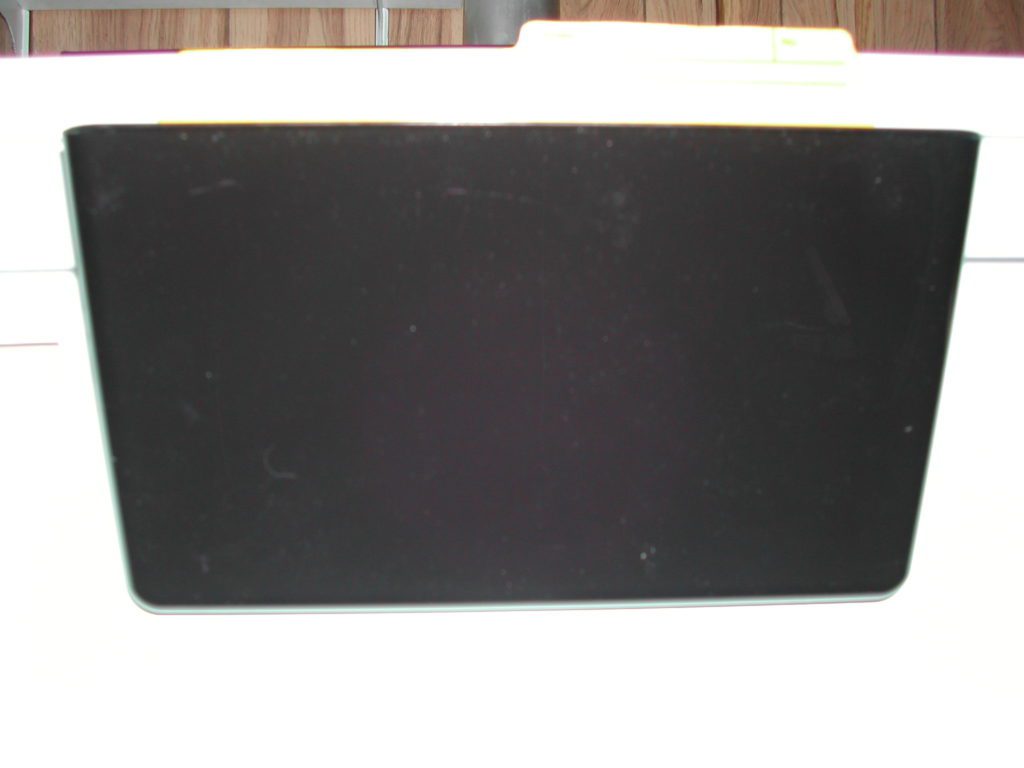

Unused / Hidden Spaces
There are unlikely places in the home that can be turned into great storage areas. Under the staircase can be lined with cedar to become a storage area for clothes or bedding. It can be fitted with a bar to hang clothes or shelves for storing containers.
Furniture with Storage
Using pieces of furniture is a great way to make additional storage spaces. A simple chest of drawers can be used in an entranceway to store hats, mitts, pets’ leashes, keys etc. An antique dining room buffet with drawers can be used to store CDs and DVDs. Two-drawer filing cabinets can be used as a night table in a child’s bedroom holding books and toys and later used for school work as the child matures.
When you need to make space to store items think outside the box, many spaces can be used to creatively and attractively store the things you need and love.


Contact her at julie@mindoverclutter.ca
Twitter – Facebook – Facebook group Organizing Mind and Space
Reading time – 2 minutes
In my travels, I have seen some great organizing ideas and products. Most of them can be created using items you already own. Save money, have fun and create a solution to an organizing problem.
Re-purpose an item and use it in a new way
On my trip to Vancouver, I learned about this idea. Here is a silver chest.
It now holds makeup. My daughter-in-law invented this creative solution.
Stack 2 tables to create a great look
I travelled to Iceland with my 92 year old Father. A coffee shop had these versatile coffee tables.
They can be easily separated to give more tables, slide over top of each other to leave more floor space and provide 2 different height tables at the same seating space. Imagine how you could create this look at your home with 2 tables.
Use stacking bins for laundry
When I was in Yellowknife I saw these great stacking laundry bins
They use vertical space so take up less floor space and can easily be separated to take to the laundry room. The thing I liked is that you can put items into the bottom bin without removing the top bin. If you have some bins around the house try using them for your laundry. You may need to set one across the other in an X pattern to be able to stack them.
1 in 4 garbage can
While staying in a hotel in Ontario I noticed this great recycling idea.
It made recycling very easy. It was all in one place, the corners were labelled so you knew where to put your cans, paper, garbage and glass. You can easily make dividers for the garbage cans for bedrooms. It would make collecting the garbage easy, only one container, and it would be sorted and ready to add to the larger containers going out to the curb.
Shoe Organizers are Versatile
When I was in Bermuda I saw one in a bookstore used to organize maps. The pockets are large and the organizer can be hung over a door, mounted on a hanger and put in a closet or fastened to a wall.
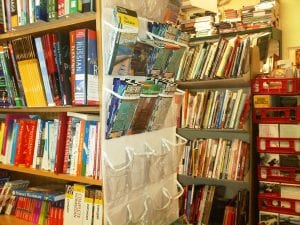

Shoe organizers can be used to organizer lots of things, hats, mitts, first aid supplies,cleaning supplies and maps
Re-purpose a piece of furniture
Using furniture in a new way can be fun. Use old furniture as storage and save money not buying bins. Back at home, this used to be a buffet.
It holds our CD collection perfectly. I knew I would not have room to use it in the eating area but it keeps the entertainment equipment CDs and gaming equipment neat and organized.
I went to the Canadian National Home Show, check out this blog post for more creative organizing ideas. What’s new at the home show?
Share your creative organizing solutions in the comments below.





Contact her at julie@mindoverclutter.ca
Twitter – Facebook – Facebook group Organizing Mind and Space
Organizing Challenges Unraveled – Recycling and Donating
OES Ontario Electronic Stewardship
If you are looking for locations to recycle your computers, TV, printers, fax machines, etc., this website will help you find a location near you.
Highlight Consumer/Retailers then click on Recycle your electronic
Go to the bottom of the page and type in the name of your city in Ontario and it will give you a list of locations
Books
If you have books you would like to donate, libraries and used bookstores may take them. There is a new organization that is able to put books into prisons. It is called Books to Bars. It is dedicated to promoting literacy, creativity and functionality in correctional facilities.
Clothing
Clothing can be donated to women’s shelters as well as Salvation Army, Value Village, and New Horizons Store on James St, Hamilton ON. There is a children’s store called Once Apon a Child and a teen and young adult store called Plato located at Guelph Line and Upper Middle Road, Burlington ON. They are not consignment stores. You bring in your clothes and they buy them (what they want) on the spot and give you the money right away.
Building Supplies
Habitat for Humanity Restores will take building supplies. Call ahead to see if they need the items that you wish to donate.
Antique Stores
Some antique stores will take window frames, furniture etc. I have an artist who is looking for antique items to use in her craft business.
Decore on a Dime
This store is located in Hamilton, ON and will take some stylish home furnishings on consignment.
Orange Drop
Check out this website to learn locations to drop off your corrosive, flammable, explosive and toxic items.
Single Use Batteries
Rechargeable batteries can be dropped off with your electronics but they will not take single use batteries. Try contacting your local stores to see if there is a collection depot for single use batteries.
Please go to www.mindoverclutter.ca and click on the links page for more ideas about recycling and donating good used items. If you have any questions or other great recycling and donating ideas click on the contact page, I’d love to hear from you.





Contact her at julie@mindoverclutter.ca
Twitter – Facebook – Facebook group Organizing Mind and Space
